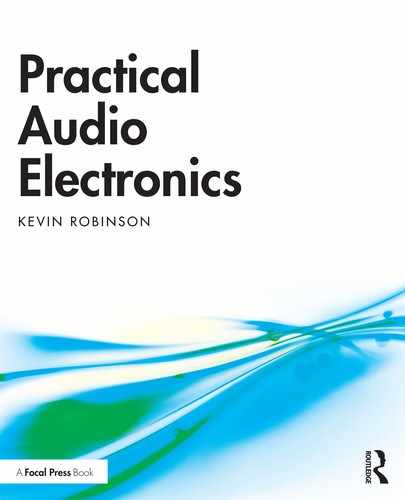A | Prefix Multipliers
When measuring the magnitude of electrical signals and the size of electronic components, very large and very small numbers are soon encountered. In order to make such quantities more manageable, standard multiplier prefixes are employed. The reader will surely be familiar with millimetres (mm) and kilograms (kg): a millimetre is one thousandth of a metre and a kilogram is a thousand grams. It is important to be familiar with the range of most commonly used multipliers. Those representing factors of 1,000 (multiplying and dividing by a thousand, a million, a billion etc.) are presented in Table A.1.
Multiplier |
Symbol |
Symbol |
1012 |
T |
tera- |
109 |
G |
giga- |
106 |
M |
mega- |
103 |
k |
kilo- |
100 |
= 1 |
– |
10−3 |
m |
milli- |
10−6 |
µ,u |
micro- |
10−9 |
n |
nano- |
10−12 |
p |
pico- |
Notice that the first three multipliers use capital letters, while the rest are all in lowercase. Misuses will often be encountered, especially capital K for kilo (e.g. KB instead of kB for kilobytes). It is wrong but not vitally important, except in the case of the prefixes m and M, as these two have different meanings, lowercase for milli(divided by a thousand), and uppercase for mega- (multiplied by a million). Also note that the official symbol for micro-, one millionth is the lowercase Greek letter mu (µ) but the letter u can be used instead as indicated in the table, since Greek symbols are not always conveniently available when writing in a word processor.
As examples of the kinds of places where these multipliers can be encountered see the list below for each from biggest to smallest, with examples of where they might be found:
Tera – the capacity of large computer hard drives is measured in terabytes (e.g. 16TB)
Giga – the clock speed of a computer might be specified in gigahertz (e.g. 2.4GHz)
Mega – mid sized media files might be measured in megabytes (e.g. 22MB)
Kilo – distances in kilometres or frequencies in kilohertz are common (e.g. 12kHz)
Milli – millimetres of course for short distances, or milliwatts for power (e.g. 100mW)
Micro – microsecond, micrometre (aka micron) are both common (e.g. 500µm)
Nano and pico – less common, but used to measure capacitors (e.g. 22nF/33pF)
Factors to indicate multiplication and division by ten and a hundred are also in fairly common use. These are presented in Table A.2.
Multiplier |
Symbol |
Prefix |
102 |
h |
hecto- |
10 |
da |
deca- |
100 |
= 1 |
– |
10−1 |
d |
deci- |
10−2 |
c |
centi- |
Hecto – not many common usages. The hectare is 100 ares, 10,000 square metres
Deca – a multiple of ten, a decathlon has ten events, a decade is ten years etc.
Deci – the most important usage here is in the decibel (dB), one tenth of a bel
Centi – commonly used, one hundredth: centimetre, cent (in money and music) etc.
The symbol for a prefix is considered to be combined with the unit symbol to which it is attached, forming a new unit symbol, e.g. centimetre (cm), microfarad (µF) etc.
When writing decimal values, the prefix symbol is often used in place of the decimal point for clarity. A decimal point can be easily confused or misplaced in small or unclear writing or printing. So for instance a resistor labelled 4k7 has a value of four point seven kilohms or four thousand seven hundred ohms.
